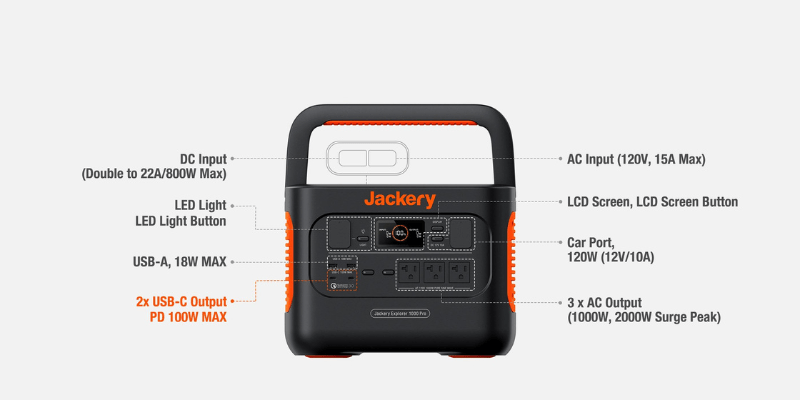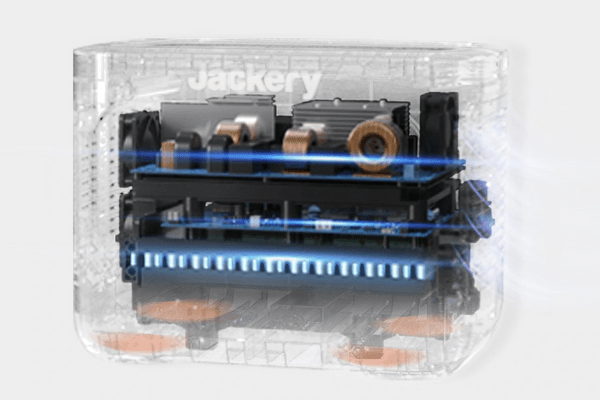The world isn’t just talking about clean energy anymore — it’s demanding it. Between record-breaking heatwaves, unstable grids, and a rising desire for self-sufficiency, more people are looking beyond gas-powered generators to something quieter, greener, and easier to manage.
That’s where portable solar generators come in — a category that has exploded in popularity, especially among campers, homeowners, van-lifers, and emergency preppers. These compact, rechargeable power stations offer a way to keep essential devices running, all while reducing your carbon footprint.
Enter Jackery, one of the most recognizable names in the space. And at the center of its lineup? The Jackery Explorer 1000 Pro — a mid-range solar generator designed to bridge the gap between weekend adventures and home backup security.
But is the Jackery Explorer 1000 Pro still worth it in 2025? And more importantly, is Jackery a brand that delivers on its green promise?
Let’s find out.
Jackery’s Sustainability Philosophy: Greener Power, One Generator at a Time

Jackery didn’t just build a power station — it built a vision around clean, portable energy. Since its founding in 2012 by a former Apple battery engineer, the brand has been laser-focused on replacing gas-guzzling generators with silent, solar-powered solutions.
Its signature Explorer Series, including the Jackery Explorer 1000 Pro, is engineered with one core mission: make off-grid energy cleaner and more accessible. And it’s not just about the product — Jackery backs its designs with broader environmental goals.
The company has collaborated with environmental organizations like the National Forest Foundation and has promoted eco-camping campaigns across the U.S. and Europe. It also pushes for lower e-waste through long-lasting lithium battery technology and simplified recyclability at the end of product life.
That said, Jackery’s sustainability credentials, while notable, don’t go entirely uncontested. The company still primarily uses NMC lithium batteries, which have a shorter lifecycle compared to LiFePO4 (LFP) batteries now favored by other solar generator brands for longevity and safety. And while the brand does use recyclable materials, it doesn’t yet offer a formal take-back or recycling program for old devices.
Still, if your goal is to switch from fossil fuel-powered backups to a solar-first system — Jackery is undeniably pushing the needle forward.
Jackery Explorer 1000 Pro Specs — And What They Actually Mean for You
Battery Capacity: 1002Wh
The Jackery Explorer 1000 Pro comes equipped with a 1002 watt-hour battery — a number that may not mean much on its own, but it translates to real, usable power for everyday situations.
This capacity can easily charge your smartphone over 80 times or keep a laptop running for 12+ hours. It’s enough to power a mini fridge for about 17 hours or run a CPAP machine through the night, making it a reliable choice for camping, power outages, or off-grid living.
Output Power: 1000W Continuous / 2000W Surge
With a 1000W inverter, the unit can safely run most low- to mid-wattage devices — think laptops, TVs, projectors, fans, Wi-Fi routers, and even a coffee maker.
The 2000W surge capacity ensures that brief startup spikes from appliances like mini fridges won’t trip the system. However, this generator isn’t meant for heavy-duty use.
High-wattage tools or appliances like microwaves, toasters, or electric heaters are off the table.
Charging Time
This is where the 1000 Pro pulls ahead of most competitors. Using dual AC wall inputs, it charges fully in about 1.8 hours.
With two 200W solar panels under direct sunlight, it hits full charge in just over two hours. That kind of speed gives it a serious advantage for users who are on the move or living in areas where daylight hours are limited.
Ports and Connectivity
Jackery includes just the right mix of ports to support modern users:
| Outlet Type | Number of Outlets |
|---|---|
| AC 120V Pure Sine Wave (1000/2000W) | 3 |
| DC 12V 120W Car Port | 1 |
| USB-C (100W) | 2 |
| USB-A (18W) | 2 |
You can fast-charge two laptops simultaneously or run your phone, cooler, and router — all at once — without juggling power strips.
What Can the Jackery Explorer 1000 Pro Power?

The Jackery Explorer 1000 Pro can power a variety of appliances. Thanks to the pure sine wave inverter, you can safely plug in sensitive electronics.
When compared to Bluetti AC200P’s 17 outlets, the Explorer 1000 Pro doesn’t seem very promising.
But again, honestly, do you need to power/charge all of those devices at once?
Three AC outlets will power everything I can think of on a typical camping day, with USB ports and the 12V ready to jump in an emergency.
Let’s take a look at a couple of appliances and gadgets I tested at home:
| Appliances | Wattage | Running Time |
|---|---|---|
| Coffee Maker | 550W | 1.5 Hours |
| Microwave | 700W | 1.2 Hours |
| TV | 60W | 13 Hours |
| Standing Fan | 45W | 17 Hours |
In the outdoors, the results were nothing short of amazing:
| Appliances | Wattage | Running Time |
|---|---|---|
| Electric Heater | 350W | 2.5 Hours |
| Electric Kettle | 850W | 1 Hour |
| MacBook | 65W | 17 Charges |
| iPhone 11 | 18W | 56 Charges |
Size and Portability
At 25.4 pounds and roughly the size of a small cooler, the Jackery Explorer 1000 Pro is lightweight and easy to store. The sturdy foldable handle adds to its portability, making it ideal for van life, RVs, and cabin setups. For what it offers, the weight-to-power ratio is excellent.
The bottom line? This isn’t a whole-home backup system, and it’s not trying to be.
The Jackery Explorer 1000 Pro is built for people who need a reliable, mid-size solar generator that covers essential devices without dragging down your mobility or budget.

Pros and Cons of Jackery Explorer 1000 Pro
Pros
Cons
- Compact and portable
- Long lifespan
- Great stand-by time
- 3 charging modes
- Super-fast solar charging
- Smart screen
- App control
- LED light
- IP68 dust and water resistant
- Average power and capacity
- Works only with SolarSaga panels
Jackery’s Solar Generator Lineup — And Where the 1000 Pro Fits In
While the Jackery Explorer 1000 Pro is often the sweet spot for many users, it’s just one piece of a well-developed product ecosystem. Jackery’s lineup, officially known as the Explorer Series, ranges from ultra-portable units for basic needs to high-capacity power stations designed for more serious energy demands.
At the lower end, you’ll find models like the Explorer 240 and Explorer 300. These compact units are perfect for charging phones, tablets, and cameras — ideal for solo camping or weekend getaways where portability is everything. They’re affordable, lightweight, and recharge fast, but don’t expect them to run appliances.
Step up to the Explorer 500, and you get a bit more flexibility. It can handle small fans, Wi-Fi routers, and even a CPAP machine for a night or two. Still, it’s best suited for light-duty users who value portability over power.
The Explorer 1000 Pro lands right in the middle of the lineup — combining practical capacity with fast recharge times and enough output for everyday essentials. It’s a popular pick for RV enthusiasts, families, and anyone preparing for short-term power outages. It hits the sweet spot for features, portability, and price.
For users with more demanding needs, the Explorer 2000 Pro and Explorer 3000 Pro bring serious muscle to the table. With higher wattage and larger battery banks, these units can power full-size refrigerators, power tools, or multiple devices at once — making them ideal for home backup or extended off-grid use. However, the tradeoff is weight and price.
Jackery has also begun bundling their units with SolarSaga panels into full Solar Generator kits, which makes solar adoption easier for new users. These kits come pre-configured, so all you need to do is plug and charge — no solar expertise required.
Whether you’re a weekend camper or preparing for the next blackout, there’s a Jackery model built for your use case. The key is matching your power needs with the right size — and that’s where the 1000 Pro shines for most users.

Where Jackery Falls Short: Honest Drawbacks to Know
For all its strengths, Jackery isn’t a perfect brand — and depending on what you’re looking for in a solar generator, there are some areas where it clearly lags behind the competition.
First up, battery chemistry. Most Jackery models — including the 1000 Pro — still use NMC lithium batteries. While these are safe and reliable, they typically offer fewer charge cycles than LiFePO4 (LFP) batteries now used by brands like Bluetti and EcoFlow. That means shorter long-term lifespan, especially if you’re a heavy user relying on daily cycles.
Then there’s the lack of a smart app or Bluetooth/Wi-Fi integration. Many newer generators let you monitor battery levels, temperature, and power usage from your phone — which is a game-changer if you’re managing a remote setup or need real-time stats. Jackery hasn’t caught up yet, and for a brand positioning itself at the premium end, that’s a noticeable omission.
Modularity is another sore spot. Unlike some competitors, Jackery doesn’t offer expandable battery packs. What you buy is what you’re stuck with. If your power needs grow — say you upgrade to a bigger van setup or add more appliances — you’ll likely have to buy an entirely new unit instead of adding capacity.
And finally, while Jackery puts a lot of energy into its eco-friendly image, there’s currently no formal recycling or trade-in program for end-of-life products. That may not be a dealbreaker for everyone, but it does matter for eco-conscious buyers who want a closed-loop product experience.
To be clear: Jackery is still one of the most reliable and user-friendly brands out there. But in terms of innovation, future-proofing, and battery tech, it’s starting to feel a step behind the new wave of solar generator players.
Jackery Explorer 1000 Pro Alternatives
| Jackery Explorer 1000 Pro | Jackery Explorer 1000 | Bluetti AC200P | EcoFlow Delta 1300 | |
|---|---|---|---|---|
| Battery Capacity | 1002Wh | 1002Wh | 2000Wh | 1260Wh |
| Battery Cell Type | Lithium-ion | Li-ion NMC | LiFePo4 | Li-ion 18650 |
| Life Cycles | 1000 Cycles to 80%+ Capacity | 500 Cycles to 80%+ Capacity | 3500 Cycles to 80%+ Capacity | 800 Cycles to 80%+ Capacity |
| Rated Power (PSW Inverter) | 1000W | 1000W | 2000W | 1800W |
| Surge Power | 2000W | 2000W | 4800W | 3300W |
| Charging Time | 1.8 hrs (AC) 1.8 hrs (Solar) | 7 hrs (AC) 8 hrs (Solar) | 4 hrs (AC) <3 hrs (Solar) | 1.6 hrs (AC) 3.5 - 8 hrs (Solar) |
| Car Charging Availability | Yes | Yes | Yes | Yes |
| Solar Input | 800W | 200W | 700W | 400W |
| Weight (Approx.) | 25.4 lbs | 22 lbs. | 60.6 lbs. | 31 lbs. |
| Portability | High | Very High | Average | High |
| Price | $1,099 | $1,099 | $1,699 | $1,399 |
Final Verdict: Is Jackery a Brand You Can Trust?
Jackery didn’t invent the solar generator — but they certainly helped make it mainstream. With clean designs, intuitive usability, and dependable build quality, it’s easy to see why their name is nearly synonymous with portable power.
The Jackery Explorer 1000 Pro is a solid middleweight in their lineup — ideal for campers, RVers, digital nomads, and homeowners who want to keep the lights on during a blackout without hauling around a gas generator. It’s fast to recharge, easy to carry, and capable of powering your essentials without breaking a sweat.
But here’s the thing: Jackery isn’t for everyone. If you’re chasing cutting-edge battery tech, modular expandability, or app control, brands like Bluetti or EcoFlow might fit you better. And if you want a power station that grows with your needs or lasts 10+ years of daily cycling, LFP-powered options will serve you longer.
Still, if your priority is reliability, simplicity, and real-world-tested performance, Jackery holds its ground — and then some. It may not be the flashiest name in the game, but when you’re off-grid or in the dark, what matters most is knowing your gear just works.
And Jackery? It just works.


